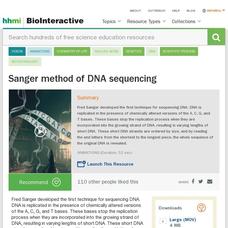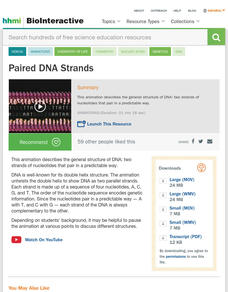Gresham College
Our Future Off Earth - Professor Christopher Impey
What are the latest developments in Space investigation? What might the future hold? ...When might we start living on Mars? http://www.gresham.ac.uk/lectures-and-events/our-future-off-earth The Space Age is half a century old. Its early...
Gresham College
Gene Therapy - The Future Has Arrived! - Alan Boyd
Using DNA and gene-based therapy to treat human diseases may sound like science-fiction, but there are already several gene therapies in use today, for diseases such as muscular dystrophy and cystic fibrosis. This lecture will describe...
Gresham College
Is Man Just Another Animal? - Professor Steve Jones
Many people agree with Gilbert and Sullivan that Darwinian man, though well behaved is nothing but a monkey shaved. The recent discovery that we share around 95% of our DNA sequence with our closest relative suggests that there may be...
Gresham College
Incest and Folk-Dancing: Two things to be avoided - Professor Steve Jones
How closely are we related to each other, and how recently do we all share an ancestor? The answer to those questions is: closer and more recently than you might think. Professor Jones discusses patterns of relatedness in ancient and...
Gresham College
Think Like a Leader: A "How To" of leadership thinking - Dr Liz Mellon
Academics have spent decades studying leaders, trying to decode the DNA that can be passed on, in order to develop leaders at all levels. As a result, we have a whole industry dedicated to describing, observing and measuring the...
Curated Video
Why Are Human Breasts So Big?
Breasts come in different shapes and sizes. They are unique to humans. More than 5,000 mammalian species inhabit this planet. Yet, Homo sapiens are the only life forms with permanent breasts. Some may call this human anomaly sexy. But it...
Curated Video
Genetic control and the mammalian radiation
To grow tissues in our body two key types of DNA control how, where and when to build essential proteins. Recent comparisons of mammal genomes show that instructions coding how to build proteins are similar across diverse species. In...
Next Animation Studio
Japanese test detects Ebola in 30 minutes
A collaboration between Japan's Nagasaki University and Eiken Chemical has developed a test that can detect an Ebola infection in 30 minutes. After blood is taken from a patient, RNA is extracted from the sample and synthesised into DNA,...
Catalyst University
How is the Coronavirus Tested Via the CDC
In this video, I do a very basic explanation of how the Coronavirus (COVID-19) is tested, according to the CDC's protocol.
Catalyst University
The Nuclear Pore Complex: Nuclear Import, Export, & RAN
In this video, we discuss the mechanisms by which proteins are targeted to the nucleus (import) and moved from the nucleus to the cytoplasm (export). Collectively, nucleocytoplasmic transport is regulated by the nuclear pore complex and...
Catalyst University
Infrared (IR) Light Therapy | Theory, Use, & Parameters
In this video, we explore the theory, use, and parameters with infrared (IR) light therapy, a sub-type of thermotherapy with a different mechanism.
Ancient Lights Media
Cells - Ribosomes
Cell Structure and Function Set: 10. This clip looks at the structure of ribosomes and examines how they facilitate protein synthesis during the translation of M-RNA.
Howard Hughes Medical Institute
DNA Transcription (Advanced Detail)
Transcription happens in every cell, including plants, animals, and in all living matter. Observe the process of transcription through a slow and detailed animation of the process. With each step described in detail, viewers comprehend...
Howard Hughes Medical Institute
DNA Transcription (Basic Detail)
A double helix looks similar to a curled zipper. Viewers see transcription, which appears similar to unzipping the DNA. The basic level of detail works well as an introduction to transcription, RNA, and proteins.
Howard Hughes Medical Institute
Regulation of Eukaryotic DNA Transcription
DNA transcription finds regulation in a few different forms. Pupils learn about the activators, repressors, and the relationships with RNA through a short animation. After viewing the process with colors highlighting each step for...
Crash Course
DNA, Hot Pockets, and the Longest Word Ever
Show learners how DNA transcription works with a video that details the step-by-step instructions required to copy genes, and how cells follow those instructions, via translation, to produce proteins and enzymes that help build further...
Khan Academy
DNA
The picture of the DNA double helix provides a logical start to describing how the base pairs match up and how the order codes for a chain of protein molecules. Three billion of these base pairs code for any protein present in your body....
Stated Clearly
What is DNA and How Does it Work?
Explaining exactly how DNA works to provide genetic information is a complex topic, but it is presented in a clear and engaging way through a five-minute video. Have learners try to explain how DNA works before watching the video, then...
Bozeman Science
Transcription and Translation
AAG-CCT-GAA: Can somebody translate this for me? A video demonstrates how transcribing and translating DNA is similar to reading a cookbook to make a meal. Scholars walk through the steps of transcription, converting genes to mRNA. Video...
Howard Hughes Medical Institute
Damage to DNA Leads to Mutation
While our bodies have incredible capabilities to repair damage, some mutations accumulate and lead to disease. Follow the life of a DNA mutation using a computer-generated animation. The narrator explains the impact of radiation,...
Howard Hughes Medical Institute
DNA Replication (Schematic)
Explore the beginnings of the theory to explain DNA replication using an eye-catching animation. Scholars view a simple rendition of DNA replication with an explanation of the first theories suggesting its existence. The animation shows...
Howard Hughes Medical Institute
Sanger Method of DNA Sequencing
Fred Sanger created the first method of sequencing DNA in 1977 using chemical alterations. Learn more about the Sanger method with a brief animation demonstrating the replication, ordering, and piecing together steps in the process.
Howard Hughes Medical Institute
DNA Packaging
One thing that all cells have in common is the DNA in their nucleus. An animation demonstration models how six feet of DNA fits in each and every nucleus of each cell. The content includes information about the components of DNA and how...
Howard Hughes Medical Institute
Paired DNA Strands
What happens when you untwist and unzip DNA? View the fascinating process and learn about the pieces that make up DNA in an informative video. It highlights the base pairing and sequencing rules within each strand.





















